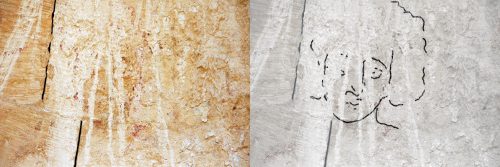So far, no works with the face of Jesus in churches from the Byzantine period have been discovered in Israel. Such a rare Byzantine work has now been identified by Dr. Emma Maayan-Penner and Dr. Royat Lin from the University of Haifa on a wall painting in the northern church in Shveta. In the painting, Jesus appears as a young boy with short curly hair

A wall painting from the Byzantine period in which the Christian Jesus is depicted as a young boy, the first of its kind in Israel from this period, was discovered during excavations conducted by the University of Haifa in Shveta in the Negev. The wall painting is found in the northern church in Shveta and it probably depicts the scene of the baptism of Jesus by John the Baptist, who is also identified in the painting. "Due to the poor state of preservation of the wall painting, in which few remains of paint remain and because it is located high up, in a place that is difficult to see, it was easy to 'miss' its existence, despite various studies done on the site. And all of a sudden, perhaps because the sun's rays just illuminated the place, I look up and see a pair of eyes looking back at me," said Dr. Emma Maayan-Penner from the Department of Art History at the University of Haifa and a member of the scientific excavation project at Shveta conducted by the University of Haifa. The rare discovery of the face of Jesus Christ was published in the prestigious journal Antiquity..
The Shevta excavation project, led by Prof. Guy Bar Oz from the University of Haifa, has been going on for several years and has led to quite a few new discoveries about the reasons for the collapse of Byzantine society in the Negev in the seventh century AD. But finding the mural of the face of Jesus is unusual and significant even for the current project. The identification by Dr. Maayan-Penner, together with Dr. Ruit Lin, head of the Department of Conservation in the Department of Archeology of the University of Haifa, is the first found within a Byzantine church in the Land of Israel - the birthplace of Christianity.
The moment of discovery, in which Dr. Ma'ayan-Penner recognized the pair of Jesus' eyes gazing into her, occurred in the apse of the baptistery building in the upper part of the apse, just above the baptismal font in the northern church in Shveta. According to the researchers, although the church itself was excavated and studied many years ago, the location of the painting and the fact that very little survived of it meant that the researchers simply passed by it over the years, without noticing it. When Dr. Maayan-Penner and Dr. Lin looked closely at the alcove, they were able to identify the remains of additional lines and spots of paint. Already at this stage it was clear to them that they were looking at a painting in which two figures are depicted. After the mural was photographed in high resolution and under different lighting conditions by Dr. Maayan-Penner's partner, the photographer Dror Maayan, the two were able to more clearly identify the remains of the painted scene in front of them: a boy or a young man, with short curly hair and big eyes, and to his left remains Another, oversized figure with an aura. "The location of the painting, above a baptismal basin in the shape of a cross, in addition to other characteristics such as the location of the remains of the figures allowed us to identify that this is the scene of the baptism of Jesus. We have no doubt that, similar to other scenes of the baptism, this painting also had additional details that have disappeared over the years," said Dr. Lin.
The new identification is unique not only because it is the first found in Israel from this period, but also because it sheds new light on the development of Christian art over the years, and therefore also on the development of Christianity itself. According to Dr. Maayan-Penner, the familiar image of Jesus in art throughout history is of a figure with long hair, often with a black beard. And here, in this painting Jesus is depicted as having curly hair and facial features with Middle Eastern features.
The team from the University of Haifa continues the unique interdisciplinary research that will be led by Dr. Lin and Dr. Maayan-Penner together with Dr. Yotam Teper and Prof. Bar-Oz as part of the excavation project in Shveta. As part of the research, the details of the mural will be studied and researched in order to ensure its preservation in the future. In addition to studying his iconographic plan, the researchers intend to examine the materials and techniques that were used and determine the optimal conditions for preserving the rare, important and sensitive ancient Byzantine relics that have survived on the stone walls in the Negev for over 1500 years.

2 תגובות
I mean I read the article. But there is no certainty.
Sorry for the question: how do you know it's Jesus and not Yohanan or Akiva.